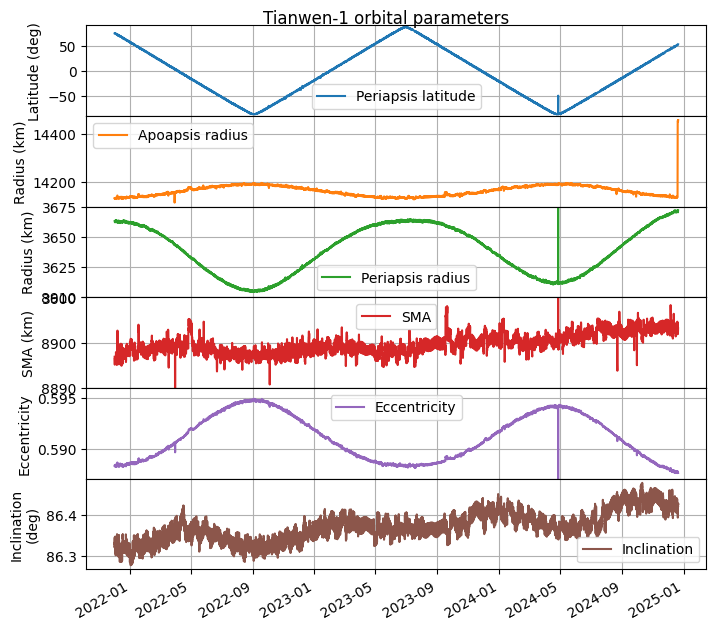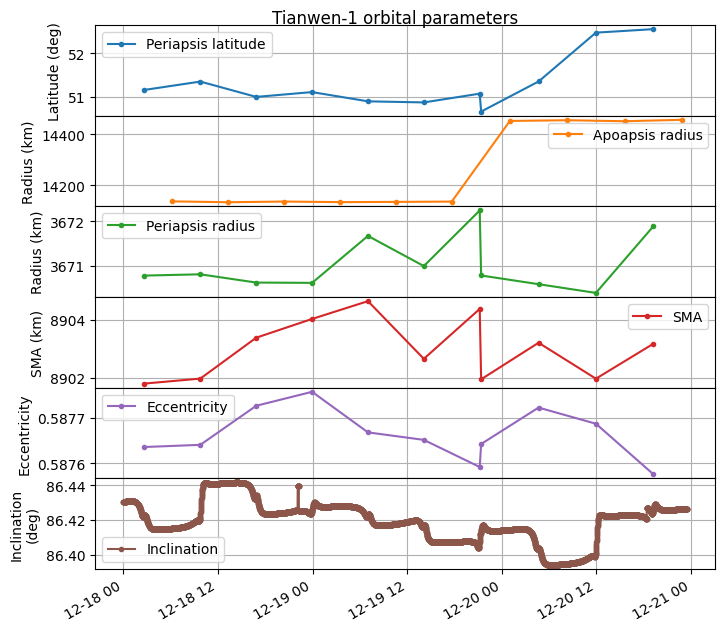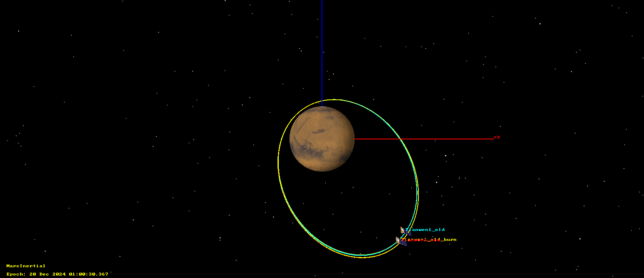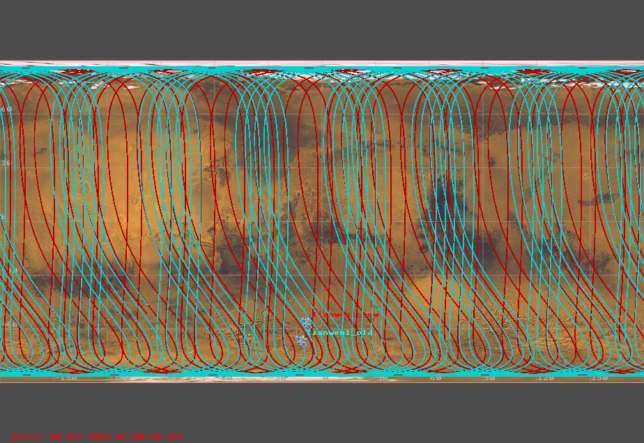For a long time, AMSAT-DL has been using the 20 meter antenna in Bochum observatory to receive some telemetry from Tianwen-1, the Chinese Mars orbiter, almost daily. Since the telemetry includes the spacecraft’s state vectors, we can use this to monitor the spacecraft’s orbit. In 8 November 2021, Tianwen-1 entered its remote sensing orbit. This is an elliptical orbit with a period approximately 2/7 Mars sidereal days plus 170 seconds. This causes a ground track that is almost repeating, but drifts slowly to cover all the surface area of the planet.
I have been posting yearly updates about Tianwen-1’s orbit, the last of them this summer. In these updates, we can see that no manoeuvres have happened, and the changes in the Keplerian elements correspond to orbital perturbations caused by external forces. The orbit is in fact designed to cause the latitude of the periapsis to precess. In this way, all the surface of Mars can be scanned from low altitude.
Now we have some news. In the telemetry of the last few days we have detected that Tianwen-1 has raised its apoapsis radius from about 14134 km to 14489 km. All the data we have indicates that a propulsive burn has happened recently. In this post I give the details about this apoapsis raise manoeuvre.
The following plot shows the evolution of Tianwen-1’s orbital parameters. This is the same kind of plot I have been showing in previous posts. A clear jump in apoapsis radius is seen at the end of the plot. This almost looks like a glitch in the data, similar to the one near 2024-05.

A zoom to the last few days of data shows that this does not seem to be a glitch. The increase in apoapsis radius persists for all 2024-12-20. Each of the points in the apoapsis radius plot is an apopasis crossing.

The last telemetry state vector received before the apoapisis radius change is the following.
2024-12-18 23:24:53.891800 4138.192797435753 1565.1651958612492 3704.175680475121 -2.8599610449442743 -0.8436723002338092 1.0683229124959517
The first telemetry state vector after the apoapsis radius change is this one.
2024-12-19 21:15:03.997700 -705.8100617306486 23.978781641523167 3778.3148440186437 -3.707915047671443 -1.2766933363575288 -1.4651427148170397
To understand better this manoeuvre I have done a simulation in GMAT. In this simulation I have three spacecraft:
Tianwen1_old. This spacecraft corresponds to the state vector before the apoapsis radius change.- Tianwen1_new. This spacecraft corresponds to the state vector after the apoapsis radius change.
- Tianwen1_old_burn. This spacecraft starts with the state vector vector before the apoapsis radius change, and performs an impulsive burn to match what
Tianwen1_newis doing.
Since it seems that the only orbital parameter that has changed significantly is the apoapsis radius, a prograde burn at periapsis is most likely the manoeuvre that has happened. I can use GMAT’s solver to find the delta-V that increases the apoapis radius to 14448.609 km, which is the radius of the first apoapsis of Tianwen1_new. This gives 9.643 m/s.
However, between 2024-12-18 23:24 and 2024-12-19 21:15 there are multiple periapsis passages. We need to find in which of these the burn has happened. This is easy to do. Since the orbit after the burn has a longer period, if we execute the burn too early, the Tianwen1_old_burn spacecraft will end up in the right orbit but at an earlier phase compared to Tianwen1_new. Likewise, if we execute the burn too late, Tianwen1_old_burn will end up at a later phase compared to Tianwen1_new. I have determined that executing the burn in the third periapsis passage of Tianwen1_old_burn makes the phases match. This periapsis passage happens on 2024-12-19 14:05:51 UTC. The orbit period after the burn is 7 hours, 11 minutes and 56 seconds. The next periapsis passage after the burn is some minutes after the epoch for Tianwen1_new.
The following figure shows a screenshot of the GMAT simulation. Tianwen1_new is shown in red, Tianwen1_old is shown in cyan, and Tianwen1_old_burn is shown in yellow. We can see that the yellow orbit coincides with the cyan one until the moment of the burn. After this moment it coincides with the red one.

Before the apoapsis raise, the orbit period was approximately 170 seconds longer than 2/7 Mars sidereal days. This gave an almost repeating ground track, with 7 periapsis passages at equally spaced longitudes covered every 2 Mars sidereal days. The longitudes for these passages keep slowly drifting over time due to the 170 extra seconds. With the apoapsis raise, the orbit period has increased to approximately 850 seconds plus 2/7 Mars sidereal days, so the ground track is no longer repeating. The small fraction of the Mars sidereal day that is closest to the new period is 7/24 (the orbit period is 62 seconds plus 7/24 Mars sidereal days), although I don’t know if this is intentional or just a coincidence.
The ground track now covers the surface of Mars more homogeneously over short times. The following figure shows the ground tracks over a period of 10 days (240 hours) with the old orbit (cyan) and the new orbit (red). Looking at this figure, I think that perhaps the intention of this orbit change is to provide faster revisit times to any point on the surface of Mars, since I cannot think of another reason that justifies performing this manoeuvre.

The Jupyter notebook used for the plots in this post is here. The GMAT script is tianwen1_orbit_change_2024.script.
One comment